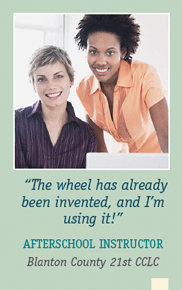 |
|
 |

Staff Development 15 Minutes at a Time When it comes to professional development, one of the most common complaints from afterschool leaders is that they don’t have the time or money for training. While it may be tempting to abandon professional development, a well-trained staff can have greater success in offering activities that will improve student achievement. Instead of sending your staff to a conference, consider using free or inexpensive resources and devoting just 15 minutes a week during a staff meeting to professional development. What follows are examples of how you can use the Afterschool Training Toolkit for professional development on academic enrichment in afterschool. Each activity below can be done in 15 minutes. All you need is a computer with Internet access. Explore the Afterschool Training Toolkit. Show your staff the toolkit at www.sedl.org/afterschool/toolkits. The toolkit has six content areas: literacy, math, science, the arts, technology, and homework help. Each content area includes the following components: information about the role the subject plays in afterschool, promising practices, sample lessons, and resources and references. After your staff has spent some time exploring the toolkit, ask them to explain the components. Learn about promising practices. Promising practices are teaching techniques used in afterschool programs with evidence suggesting they help students learn important academic content. Watch a video demonstrating a promising practice with your staff and ask them to discuss what they saw. They can also spend some time reading about the practice on the Web site. Ask your staff how they can incorporate the practice into existing lessons. Teach a lesson. Ask your staff to select a sample lesson they would like to teach and discuss the parts of the lesson. Talk about what they need to implement it. Staff should teach the lesson to their students and be prepared to report back on their experiences. Talk about what you learned. Ask staff to give feedback on how their lessons went, what worked and didn’t work, and what they would do differently. Revisit the promising practice and parts of the lesson. Do their existing lessons have these components? What changes could they make to these lessons to make them more effective? |
|
 |
|

Bladen County 21st CCLC Program
|
 |
 |
 |
||||||
|
||||||||
|
Questions or comments should be directed to: Laura Shankland This newsletter was produced in whole or in part with funds from the U.S. Department of Education under contract number ED-01-CO-0057/0001. You are welcome to reproduce issues of AfterWords and distribute copies at no cost to recipients. Please credit SEDL as publisher. Link to PDF versions of AfterWords is available here. For additional uses, please fill out and submit a copyright request form. Copyright © 2008 by SEDL. |




